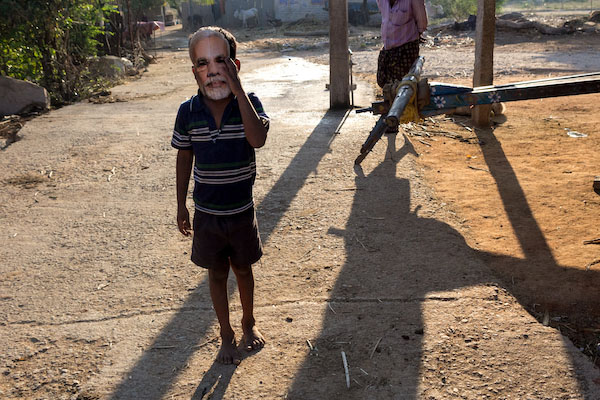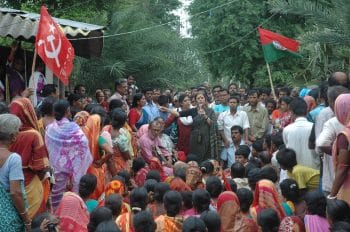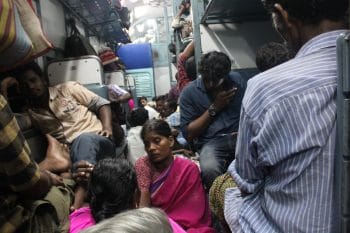In 2019, India will go to the polls. It will be the largest exercise of electoral democracy in the world. Roughly 850 million people will cast their vote across the 3.2 million square kilometres of India’s landmass. In the last general elections in 2014, the party of the far right, the Bharatiya Janata Party (BJP) won a majority in India’s Parliament (Lok Sabha). Very soon, the policies of the BJP began to create unrest in the country. An unleashed and toxic social force began openly to target vulnerable minorities, while the government began to give away social wealth to its crony capitalists. Undaunted, the BJP pushed forward. Then, two high-profile decisions came in rapid succession: the demonetisation of high-value currency notes (November 2016) and the creation of a Goods and Service Tax (July 2017). Both raised eyebrows across the country as the impact hit not only the very poor but also the small business community. Barely able to win re-election in Prime Minister Narendra Modi’s home state of Gujarat in December 2017, the BJP went on to lose a series of parliamentary by-elections and state legislative elections. The BJP appears wounded as it limps towards the general election.
Towards the end of 2018, the BJP lost three crucial state houses in north India–in Chhattisgarh, Madhya Pradesh and Rajasthan. These were strongholds of the BJP. The reason why the BJP lost these states is that the neo-liberal policies had created agrarian distress, which had not been addressed by the BJP-led state government nor by Modi’s cabinet. Farmers’ protests, led by the Left, galvanised the opposition to the BJP. One of the components of the Indian Left is the Communist Party of India (Marxist) or CPI(M). Tricontinental: Institute for Social Research’s fellows Jipson John and Jitheesh P.M. spoke with CPI(M) Politburo member Brinda Karat about the current political situation. Brinda Karat has been a member of the CPI(M) for almost five decades and was elected to the CPI(M)’s Politburo in 2005. She began her party work in the trade union movement and then led the All-India Democratic Women’s Association from 1993 to 2004. Since 2006, Karat has been working with the Adivasi Adhikar Rashtriya Manch, a platform of indigenous communities. She was a member of India’s Parliament from 2005 to 2011. This dossier carries an edited extract of the interview.
The following brief video introduction to Dossier #12 is courtesy of NewsClick
Part I: The Problem
In India, the far-right government–led by Prime Minister Narendra Modi–has entered its fifth year in office. How do you assess the past four years of this government?
I believe that India is endangered less by ‘foreign forces’ than by its own government and the ruling party, the Bharatiya Janata Party (BJP). In the past four and a half years, the government of Prime Minister Narendra Modi has launched an all-out assault on the fundamental principles of the Indian Constitution (1950). The principles of secularism and democracy, integral to our Constitution, have shaped India’s polity and society. These principles have been attacked in numerous ways by the BJP government.
As a communist, I do believe that there are many areas in which the Constitution falls far short of the requirements of the people. For example, the right to work should be a fundamental right and many of the directive principles should become fundamental rights [these Directive Principles of State Policy, such as that men and women have a right to adequate livelihood and that men and women get equal pay for equal work, are suggestions and not mandatory]. The right to property was removed through an amendment as a fundamental right but was retained as a statutory right through the introduction of Clause 300 A in the Constitution. Now, the High Courts have the right to intervene in issues that concern property rights. Look at the consequences. We now have court judgments as in Bihar that accept gods as legal entities who have rights to land. These judgments protect temples that hold huge tracts of fertile land through temple trusts controlled by the rural rich. This in a State which has a high percentage of landless rural poor. So, changes in the Constitution to protect the rights of the poor need to be made.
But today we are facing a situation where we need to defend the Constitution from attacks by the right-wing forces. We have to defend the core of the Constitution from being modified to suit the communal ideology of the BJP and its family of right-wing organisations, the Sangh Parivar.
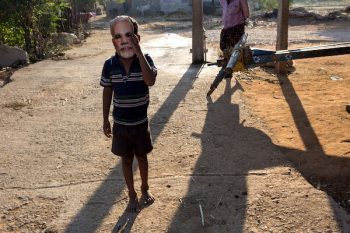
A boy in a Modi mask, in Amadagur mandal of Anantapur district. The villages of Amadagur mandal are some of the most affected villages during droughts which are very common in Anantapur. These villages have also very high rates of migration. Farmers from here often travel to cities like Cochin and Bangalore to keep up with their farming. Photo: Rahul M.
The first issue is that of secularism. The Prime Minister was an RSS pracharak [an RSS full-time worker]. The RSS, or Rashtriya Swayamsevak Sangh, is a far-right organisation that drew inspiration from the Nazi leader Adolph Hitler. Modi’s true allegiance is to the ideology of the RSS, not to the Indian Constitution, on which he took his oath as Prime Minister. He stands by the oath he took as an RSS pracharak to defend the interests of ‘Hindus’ as opposed to all Indians. As an RSS man, Narendra Modi believes in the idea of turning India into a Hindu Rashtra [a Hindu State]–a theocratic State, where citizenship is decided not on the basis of recognition of equality of all citizens, as at present, but on the basis of being Hindu. In a country of 1.3 billion, where there are 175 million Muslims as well as millions of Sikhs, Christians, Buddhists, Zoroastrians, Jains and atheists, where the very idea of India is a synthesis of pluralist cultures and beliefs, such a policy of religious supremacy is outrageous and dangerous. The principles of secularism are to be defended against the RSS, whose members have openly called for the removal of the word ‘secularism’ from the Constitution. In this context, a disturbing feature is also the growth of Muslim fundamentalist forces who are trying to divert the growing frustration of youth into sectarian lines. One fundamentalism feeds and strengthens the other. In this case majoritarian communalism is also helping the growth of Islamicist organisations.
The second issue is that of democracy. I see the defence of secularism as essentially a defence of democracy and democratic rights since it is based on the right to equality across caste, sex, creed and class. The Modi Government has also twinned its attack on secularism by diluting and destroying democratic rights of the people, by subverting the autonomy of constitutionally mandated institutions to the extent that even four senior Supreme Court judges had to warn the country through an unprecedented press conference that the independence of the judiciary and the courts was in danger. Those who challenge the BJP and their toxic ideology are branded as ‘anti-national’. Activists who fight for their rights face arrest under the draconian law against sedition, from students at Jawaharlal Nehru University in Delhi to Dalits [oppressed castes] and to Adivasis [indigenous peoples], asserting their rights over forest land. In addition, opposition leaders are selectively targeted in the name of fighting corruption. These are dangerous developments diluting civil liberties and democratic rights.
Hierarchical ideas of society–based on the Manu Smriti, the text of Brahmanical supremacy–have put pressure on minorities, women, Dalits and Adivasis. Mob lynching in the name of cow protection is a frighteningly common crime. Gauraksha(cow protection) groups have proliferated, attacking Muslims and Dalits.
Linked to this attack on vulnerable groups is a direct assault on the scientific temper and on critical thinking. When people get buffeted by the storms created in their lives by the cruelty of neo-liberal policies, the feeling of helplessness against forces over which they believe they have no control grows. Superstitions and beliefs in rituals tend to grow. Here you have a Government which not only panders to superstitions but actually encourages it. When farmers hit by drought went to a Minister for help, he asked them to organize a yagna [sacrifice] to appease the rain gods. Another Minister asked them to arrange a marriage of frogs since that makes the rain gods happy! The BJP government has also tried to undermine science by the promotion of mythology and superstition. In the name of national pride, Government ministers make outlandish statements about the existence of advanced technology in ancient India; they say that the Internet and satellites were used in the old days, and they say that cows inhale and exhale only oxygen. The Prime Minister himself claimed that ancient Indians were performing head transplants! Such drivel makes a mockery of the actual achievements in our country’s past in the field of mathematics, medicine and so on. All this creates an atmosphere where the wildest of rumours and mass hysteria thrives, sometimes reflected in other terrible mob killings of those accused of having an evil eye or of being witches.
Third, and extremely important, is the aggressive pursuit by this Government of neo-liberal policies. The BJP has continued the neo-liberal policies of their predecessors–notably the Congress-led government of Prime Minister Manmohan Singh (2004-2014). The major difference is not in their policies but in the BJP’s current absolute parliamentary majority, which allows it to push its policies aggressively. In 2004, when the Congress Party came to power it did not have an absolute majority. It relied upon other forces, including outside support in parliament from the Left. We, the Communist bloc, had to wage a sustained battle against the Congress’s efforts to push through the entire gamut of privatisation and liberalisation policies and we succeeded to some extent in blocking the laws to strip the working class of its hard-won rights. The Left was able to push for pro-people legislation–such as the Rural Employment Guarantee Act, the Forest Rights Act, and the Right to Information Act, as well as some important amendments to enhance protective laws for women. The BJP government, which took power in 2014, did not have any such pressure. It, therefore, operates as the government of the corporate sector, by the corporate sector and for the corporate sector.
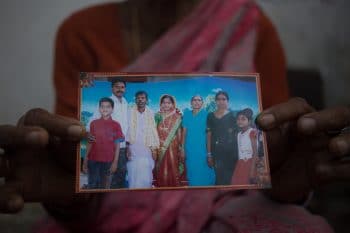
After effects of Demonetisation: (L to R) Balayya’s son Prashant, Prashant’s father Balayya, Balayya’s father Gaalayya, Sireesha, Gaalayya’s wife Vajravva, Balayya’s wife Balalakshmi and Akhila. When the government outlawed 86 per cent of India’s currency, burying his hopes of selling land to pay off debts, Varda Balayya of Dharmaram village in Telangana killed himself and tried to poison his family. Photo: Rahul M.
Because of Government policies, agrarian distress is acute. An average of 12,000 farmers committed suicide every year of this Government’s rule. Unemployment is at its highest. In a country where over 60% of the population is below the age of forty, education and jobs are critical issues. But far from the twenty million jobs Modi had promised to create every year, what we have is not just jobless growth, but jobloss growth. The disaster of demonetisation for example led to a loss of 3.5 million livelihoods in the unorganised sector. India stands out for its increased inequalities in this period of Modi’s rule. Just 1% of the population holds 68% of all household wealth, an almost twenty-point increase in the last five years. On the other hand, according to the government’s socio-economic survey, over 90% of India’s people have an income of less than 10,000 rupees a year (U.S. $143).
The BJP government likes the phrase ‘ease of doing business’. What this means is that the government has tried to dismantle the entire regulatory system that puts checks on corporate power. Corporations have registered high profits in the period of the Modi regime.
Take the example of one such corporate group that of Gautam Adani–the Adani Group–, a conglomerate that is very close to the Modi government,–registered profits of 124% within the first year of the Modi government. In effect, Adani’s firm earned profits of U.S.$25 million per day, a three-fold surge. Most of this came through the largesse of the government in handing several projects to the Adanis. Public sector banks had their arms twisted until they handed over public money to the Adani Group. The non-performing assets–a polite phrase that represents the failure of the Government to get back the loans that banks have given to corporates–stands at more than 9 lakh crores rupees [U.S.$2.9 billion] today. The BJP is the principal party of corporate power. This does not mean that the Congress Party has changed its class character. It just means that since 2014, corporates have shifted their support to the BJP, and it has become the main party of India’s ruling classes.
Fourth, its foreign policy has been decidedly pro-imperialist and specifically pro-U.S. As a junior partner to the U.S., the Government has turned its back on solidarity with third world countries, in the support to the struggle of the Palestinians, for instance.
It is for all these reasons and more that BJP rule is such a disaster for India.
The Supreme Court of India has made some sharp statements against ‘mobocracy’, the rule of the mobs. It has told the government to rein in the mobs. This is itself an indictment against the government. Despite this, the BJP says that it will not move against mob lynching–the killing of people in the cattle trade, for example. It almost suggest that there is a ‘good lynching’–a lynching to create a society that favours the BJP and RSS. One RSS leader said, ‘lynching will stop if people stop eating beef’. What do you make of the lynching epidemic and of the disregard by the RSS-BJP of the Supreme Court?
In 2015, a mob in Dadri (Uttar Pradesh) alleged that Mohammed Akhlaq slaughtered a cow, so they killed him. This crime was justified by the RSS-BJP. It was a sign of what was to come. The frequency of mob lynching has made the crime almost normal. You can be lynched for what you eat, for what you are, for what you say and for whom you want to marry. The RSS-BJP seem to suggest that some lynching is good, that those who participate in this kind of lynching are not criminals but heroes. BJP ministers go to events and garland the criminals who lynched our fellow citizens. This is a very dangerous shocking and reprehensible situation.
What do they say is a good lynching? If a mob kills a Muslim man who dares to marry a Hindu girl–what the BJP sensationally calls Love Jihad–that is seen as a good lynching. If a mob attacks Muslims for offering prayers in a public space, that is seen as a good lynching. If a mob attacks young couples for celebrating Valentine’s Day, that is seen as a good lynching. In each case, the mob is defended by the RSS-BJP.
It is equally disturbing that the police in many cases and sometimes also the judiciary have been protective towards these men. False charges are made against the families of those who are killed by the mob, and the courts have taken these charges seriously. Mohammad Akhlaq’s family has been threatened with arrest for cow slaughter–which never happened. It is a totally false case. Meanwhile, the killers of Mohammed Akhlaq walk the streets. Junaid Khan–killed on a local train in 2017–is unlikely to get justice. The First Information Report of the police suggests that Junaid Khan’s killers did so in self-defence. Once you accept that there is ‘good lynching’, there is no end to this nightmare.
In spite of the Supreme Court’s warning to the Government, top level Ministers have given official sanction to the Gauraksha [cow protectors] groups in the name of cow protection–when they are in fact nothing other than murderers. The government says that it does not have money for issues that would pertain to women’s rights, but it has money to protect cows. There is even a ministry for the protection of the cow. Modi’s government says that it does not have surplus land to give to the landless rural poor, but it allots generous amounts of land for cow shelters. Cow protection has a priority over the welfare of humans. Better to be born a cow in India today.
Immediate action needs to be taken against the killers. There needs to be a law against mob lynching. But the Modi government has no desire to frame any such law.
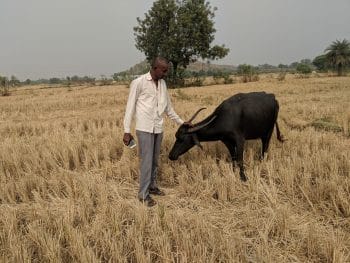
A farmer from Telangana, who is a TRS activist, with his bovine. TRS is the party which won election in telangana, a state in India mostly because of its popular somewhat welfarist policies. Photo: Rahul M.
A recent study by Reuters ranked India as the most dangerous place for women in the world. What makes India such a cruel society in terms of women’s freedom?
I don’t know the methodology they have used and what the situation is comparatively in other countries, but there has certainly been a marked increase not only in the incidence of violence against women, but also in the brutality of the violence in India. There are cases of violence against women where they are tortured, burned, beaten, raped and even killed. The details are horrific. What are the reasons? There are many but at least one is that over the past several decades, women have entered public spaces to work and to live. They have established their talents, their skills, and their capacities in numerous spheres. There has been a backlash against this increased assertion. The backlash is shaped by extreme misogyny–or a strong feeling in sections of our society that women have a specific place and anyone who crosses the boundary is liable to be punished. These cultural walls behind which women and girls are expected to live (with some exceptions for certain classes), are stronger than the high walls of a prison. When a woman is raped, she is blamed for entering public space, for being a free citizen, for the clothes she wears, for the person she speaks to, for the place and time where she was. It is the woman who is held responsible for the crime. That is the character of the misogyny.
The backlash to women’s entry into public space is not spontaneous. It is not a natural reaction. It is shaped by conservative forces, including religious orthodoxy and Brahmanical institutions. The backlash is refracted through hierarchies of religion and caste. We are seeing an increase in crimes against Dalit women who work in vulnerable situations each day, particularly in rural India. Their vulnerability to sexual harassment is greater because of the material conditions of their lives.
The idea of ‘honour killings’ has now become almost normal in India. As more girls go to schools and colleges, and as more young people have the opportunity to meet each other, the likelihood of cross-caste and cross-religious romances grows. If a woman tries to assert her choice of a life partner against her family’s wishes (particularly if she wants to marry outside the boundaries of caste and religion), then there is a likelihood that she might be killed. This murder is known sickeningly as an ‘honour killing’. In rural areas, the Khap Panchayat [Clan Assembly] emerged as the keepers of feudal traditions. Many of them have authorised the murder of young people for making their own life choices.
In Kathua (Jammu and Kashmir), an 8-year-old girl was raped and murdered in January 2018. She was targeted because she was a Muslim girl, a child of the Bakarwal community. The murder took place to send a message to the community that they should not settle in that region. It was a brutal killing. The BJP leaders in the area did not call for justice. Instead, they demonstrated on behalf of the accused. That is their attitude to these killings.
The RSS-BJP denies the existence of such so-called honour crimes. During the government of BJP leader Atal Bihari Vajpayee [1998-2004], the United Nations released a report on such ‘honour killings’. The Indian representative to the UN said that no such crime takes place in India. That is why the Indian government does not collect data on these crimes, nor does it take them seriously. Khap Panchayats are given free rein because they are used to mobilise votes in rural areas. The RSS-BJP want to create separate schools for girls and boys, to deny women entry into public space and to empower parents to control their children’s movements. This is their ‘solution’ to the problem.
As a result of the callous attitude of the government, India has one of the lowest rates of conviction for crimes against women. In any given year, at least 70% of cases are in the ‘pending’ category–that is they are yet to be heard and decided by the courts–and of the cases heard and decided 75% to 80% of the accused walk free. Some people want to bring the death penalty to India as a way to tackle these kinds of killings. I am against the death penalty in principle. Apart from all the other reasons, it is certainly not going to solve the problem or lessen the rate of crimes against women. On the contrary, as women’s organisations in India have argued, it could lead to more killings of the victims of rape so as to ensure that she does not give witness. The struggle has to be for the certainty of punishment. We do certainly need stringent punishment for barbaric sexual crimes which should include life imprisonment.
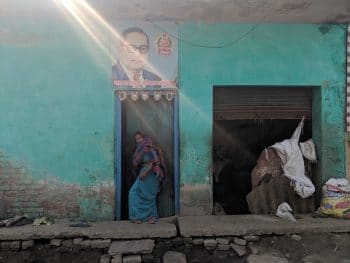
Near Saibabad area, a working class neighborhood in India’s National Capital Region (NCR). ‘‘no, this is not some office. these are our homes’ She told me when I asked her if it was some office. Photo: Rahul M.
Part 2: The Solution
There is growing resistance to the government as the country moves towards a general election in 2019. How do you evaluate this resistance?
There is definitely an increased mobilisation of different sections of the people against the BJP government’s policies. It is another matter that the mainstream media often ignores or underestimates these mobilisations. Most recently, there have been a series of marches of peasants and farmers as well as strikes by a range of workers–from day care and health care workers to industrial workers, bank and insurance employees. Central trade unions are preparing for a countrywide two-day strike in early January.
These mobilisations have been at the local, state and national level. The largest was on 5 September, when hundreds of thousands of workers and peasants, joined by women and youth marched through the streets of the capital. It was extremely inspiring. In fact, it is precisely these people’s mobilisations and the growing unity among a range of organisations working among the kisans [farmers] and workers that have forced political parties to recognise the discontent brewing across the country and all have now started speaking about the issues raised by these mobilisations. The Left-oriented mass and class organisations have played a crucial role in bringing these sections together and providing a platform for a united voice. The Left is very much in the forefront of challenging Government policies. In the context of the forthcoming elections, these organisations are also urging their members to ensure the defeat of the Government and its policies.
We will see the political impact in the coming days.
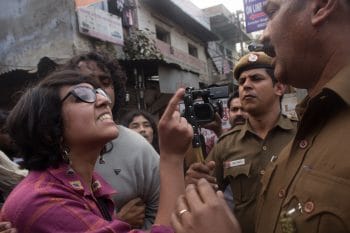
Students protesting outside the Delhi office of the Hindu-revivalist NGO Rashtriya Swayamsevak Sangh after Dalit scholar Rohith Vemula’s suicide on 17 January 2016. Rahul M.
What are the most important tasks and challenges before the Indian Left today?
We believe in revolution. We believe in socialism. These are our goals. Our day to day work might be tough and sometimes frustrating. But our work is illuminated by our aims–revolution and socialism. The challenge is to address current issues and problems while always keeping those goals in mind. If we adopt tactics to deal with current problems in a way that weakens our strategic goals, it will be self-defeating and opportunist. Communists are often advised by liberal opinion to ‘reinvent’ ourselves: to give up class analysis, to give up the principles of organisation, to be less dogmatic and so on. In other words, they are advising us to be more like them! Undoubtedly, we must be aware of the huge changes that have been wrought by the development of capitalism in India, not only in terms of the intensified exploitation and inequalities that I spoke about but also in increased urbanization, in the expansion of the middle classes, in the expectations of youth. Cultures promoted by capitalism and the market promote and glorify individualism and promote individualistic solutions. All these add to the depoliticization of a whole generation of young people. This is certainly a challenge: how to find the most effective ways of taking our message to the youth. Then again in India class exploitation is intensified through the caste system and vice versa. To build resistance struggles against the caste system and caste oppression and to link such struggles with the fight against capitalism in terms of struggles and goals is also a challenge. Trade unions and other class organisations certainly have to be more assertive and attentive to these aspects. This has been a weakness in our approach. The organised Left is limited in its reach. The Left has an influence beyond our organizational strength. We are unable to translate the influence and good will we have among people into a political mass base, except in certain traditionally strong areas like Bengal, Kerala, and Tripura.
Another challenge is the parliamentary arena. Here because of the huge power of corporate money, the Left is finding it increasingly difficult to also translate support into votes. When crores [ten million] of rupees are spent in local elections for municipal seats, you can imagine the cost of fighting for a seat in parliament. We do not take money from corporates. We have opposed the fraudulent electoral bonds system in which the identity of the donor is kept secret. The BJP received huge amounts of money through these bonds; the identity of all the crony capitalists who have paid them for favours is concealed. Electoral reforms are an important part of on our agenda of struggle. But, in the meanwhile, we have to fight elections in a highly disadvantaged situation.
In the present situation, our main task is to build up the struggles of the people against neo-liberal policies and against the communal danger posed by the BJP Government and against the Sangh Parivar. We are trying to build a Left and democratic alternative on the basis of an alternative policy framework and vision. The divisions on the basis of religion promoted by the RSS ideologies, cannot be judged only through election results. If there is a communal shift in everyday thinking and in cultural practices, it is much more dangerous. Here the Left with its uncompromising fight against communalism and to build the people’s unity–linked to common daily issues–has the credibility to fight the RSS at all levels. It is necessary to assert Left identity and Left politics even while building broad platforms to include secular forces against the RSS agenda of manuvadi Hindutva [the ideology of the RSS and the BJP].
We have a long way to go. The challenges are enormous. We are faced with a highly centralised State power with all the resources at its command. The media and communication technologies controlled by the ruling classes have become an all-powerful instrument to defend the status quo and manufacture lies about the left. Struggles for radical social transformation in this day of high technology and huge money power of parties of the ruling classes is obviously something entirely different than earlier.
Our greatest strength, which we must continue to build upon, is the daily work of thousands of dedicated activists. We are involved in the day to day issues of fighting for the livelihood and the life of the people. Only through this can we reach the people with our alternative agenda and only through these fights can we build the confidence of the people to fight for that alternative.
But we cannot ignore the new developments of technology. We must build our alternative media, including social media, as a tool of communication for people. We know that for young people this form of communication has become essential. We think the Left must not be left behind in its use of these methods of communication. We have to be creative in the way we use our traditions in the present technological landscape. We cannot give in to the form of social media, to the short attention span that it enforces. We have to use the media to build a much deeper sense of the system and to build a robust challenge to it.
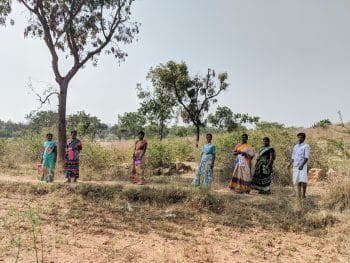
‘We built toilets and proper houses because the government promised us reimbursement. but they didn’t pay us since months. So we are going to submit petitions to the officials at janmabhoomi program today.’ Photo: Rahul M.—taken around amadagur mandal of Ananta-pur district during January 2018.
In the current atmosphere of authoritarianism, liberals–and even left sympathisers–calls for a broad coalition of all political forces against the BJP and its allies. What is your view on this?
Our political line determines our electoral tactics. We have clearly stated that our main political aim is to defeat the BJP politically, ideologically, and in all policy matters. So, certainly, in the elections we will use all our strength to achieve this aim, to throw out the Modi Government from power. This is the first point of our approach. How to achieve this? We have decided that our efforts will be to minimise the vote division against the BJP which means that we will be fighting in those seats where we have a strong base and, in all other seats, we will support the opposition party candidate in each constituency who is best placed to defeat the BJP. This will differ from State to State. In fact, it is interesting that most parties have come to the same conclusion that we had stated in our party Congress resolution, namely that given the very diverse situation in different States of India–with regional parties playing a critical role in many of them–a national alliance is not feasible and will have to be only post-poll as it has been earlier. At present, there can be State-based alliances. The CPI(M) differentiates between electoral alliances with regional parties and an all-India party of the ruling classes such as the Congress. We can have such alliances with regional parties as we have had in the past, for example in Tamil Nadu, Bihar and Maharashtra. Whether there is such a possibility of an alliance will be discussed by our organisation in the State. In West Bengal, where there is a very specific situation with the regional party the Trinamool Congress (TMC) competing with the BJP in its anti-Left and utterly authoritarian, fascistic methods, our effort will be to defeat both the BJP and the TMC.
The second most important aim is to increase the strength of the CPI(M) and the Left in Parliament. I need not go into the details here as it is self-evident that it is only when the Left has a strong presence in parliament that the defence of the people’s rights against neo-liberal policies and the fight for democracy against the toxic communal politics of the BJP-RSS can be fought. Therefore, we have to increase our strength.
The party Congress has clearly stated that both these aims have to be achieved without having a political alliance with the Congress party. We do not equate the BJP and Congress even though they represent the same ruling classes. I have given the reasons in earlier answers as to why the BJP is the greatest danger to India. Our focus is therefore to defeat the BJP. But we have to keep our alternative policy in mind when we decide electoral alliances.
Thirdly, we state to the people unequivocally that we are committed to the formation of a secular Government. The shape of that Government can be decided only after the verdict of the people.
Our election campaign will be consistent with our political line, to fight the communal authoritarian and divisive regime of the BJP and its neo liberal policy framework on the basis of our alternative policies. We do not believe that a neo-liberal agenda can defeat a divisive agenda–these two feed off each other.
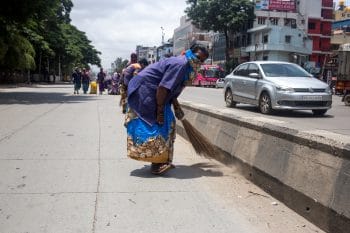
Dalits from the villages of Anantapur district sweep the streets of Bengaluru. ‘Banglore doesn’t stink because of Dalits from Anantapur,’ a woman sweeper told me. Photo: Rahul M.
In West Bengal and Tripura, the CPI(M), as part of the Left Front, governed the state for decades. In both states, the CPI(M) and the Left Front are now out of power. What steps has the CPI(M) taken to regain the political space in both states?
After we lost elections in both West Bengal and in Tripura, our organisation faced severe, harsh and continuous repression. It may be difficult for people outside of these States to even comprehend the kind of violence that our comrades are facing. Hundreds of our cadre and sympathizers have been killed in Bengal. In Tripura also, violence is being unleashed. In Bengal the violence comes from the TMC–the ruling party in that State–and in Tripura it from the BJP and RSS. Thousands of members and supporters of the Left have been forced to leave their homes and thousands of false cases have been foisted on them-20,000 in Bengal alone. Men and women of the Left are threatened that their children will be killed if they continue to support the red flag. This is all to sap the confidence of our party members and of those who voted for us. Our biggest immediate challenge has been to protect and defend the party, the party structures, the party offices, the party cadre and the homes and families of our party cadre and sympathizers. Without our committed cadre, it will be impossible to re-establish our links with the people and to continue popular mobilisations to develop people’s struggles. Protection of our cadre and continuation of our political work are linked.
We might have lost the elections, but we have not stopped our work. The parties who defeat the Left and come to power understand this resilience. These parties, like the Trinamul Congress Party in West Bengal and the BJP in Tripura, know that despite the electoral loss, the Left and the CPI(M) have a deep-rooted connection with the people, which makes this defeat only temporary. It is their understanding of this fact that explains the worst kind of repression they have meted out against us in West Bengal and in Tripura. Their effort is to physically annihilate us. They use violence against us with the aim to destroy the party by physically breaking our link with the people.
In West Bengal and in Tripura, our cadre at the grassroots are making tremendous sacrifices. Their resilience is inspiring. No political movement takes place without setbacks. The issue for us is not the attack on our party, but on the resilience of our cadre in fighting to defend the party and retain the links with the people. We now find that this resilience and bravery has led to new mobilisations and new support from the people for our party. That is a change that has come after tremendous sacrifice in West Bengal. We have moved forward, but we know that the road ahead is paved by our hard work and our determination.
The Left Democratic Front government in Kerala, with the CPI(M) as part of the government, is the only Left government in India today. What is the alternative agenda of that government and how do you assess the two years that it has been in power?
The Left Democratic Front (LDF) government is one of the few governments in India that has actually worked to fulfil its electoral promises and implement them from its first day at work. For example, the LDF promised to double pensions, which it did within its first month. The government increased the minimum wage, as promised, making it one of the highest in the country. No left programme should be blind to the need for an environmentally sustainable model of development. The Green Kerala Mission (Haritha Keralam Mission) is formulating a full-scale environmental alternative to the neo-liberal project that denies the environmental challenges we face.
Key parts of a left agenda must be education and health care. The government has allocated a substantial amount of its budget to upgrade government schools. Whereas in the rest of the country we see an exodus from government schools to private schools–with parents inundated by debt to give their children a good education–in Kerala we see parents lining up to get their children into government schools. They know that they get a high-quality education, with a progressive curriculum that takes science seriously. More funds are needed to upgrade classrooms. We do not believe that only private schools should have computers and other advanced learning technology. The Kerala education mission is trying to set up the educational infrastructure that supports the curriculum. Our government has also provided dispensers for free sanitary napkins, so that girls do not find their education disrupted by their periods.
When it comes to health care, the LDF government is pushing for a universal scheme based on universal rights. If all people get health care through a universal scheme, then you cannot divert health care to the private sector, where profit maximisation rather than health is the goal. If someone has the money to pay for private health care, and if they prefer to go to a private hospital, that is their choice. But that should remain an individual’s choice. Governments should not force people by deliberately understaffing the public health institutions and starving them of funds for better machinery. Promoting private health care at the expense of public health care is not a choice. In Kerala, we aim to provide the people with a real choice, which will be through the provision of a quality public health system. People can then choose where they wish to go. This is the vision of the left.
Kerala is leading the fight against communal division and for secularism. It is ahead in providing rights and services to minorities, including to the transgender community. The LDF fights for federalism, for the right of the state to determine its agenda and not be dictated to by the central government. We are not begging New Delhi for this or that benefit. We are saying that it is our
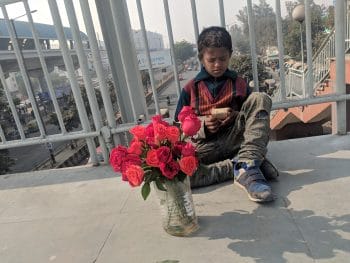
A child who sells flowers near Kaushambhi metro station, which is part of India’s National Capital Region (NCR). Photo: Rahul M.
constitutional right to get services and finances. In 2018, Kerala suffered a terrible flood. Central government assistance was meagre. Kerala’s population–and the people of India–rallied to help the rescue, relief and reconstruction. The central government provided only measly assistance, and that too after it was challenged to do so. The Kerala Government and the Left mass and class organisations set a record in exemplary service to the people. Specifically, the Chief Minister Pinarayi Vijayan must be congratulated for anchoring the entire effort with calm resolve, inspiring confidence among the people.
Kerala’s LDF had a five-year budgetary plan that was worked out to provide infrastructural spending, spending on health and education and spending for the Green Kerala Mission. Then, the flood came. This was one of the most destructive floods we have seen. Thirteen of Kerala’s fourteen districts were inundated with flood water. Every piece of furniture, every stitch of clothing, every cooking vessel, every asset went off into the flood. Attention had to focus on reconstruction. It is the word that defines the rest of the LDF tenure. The entire five-year plan had to be reviewed for the third year of the LDF government. Development is essential for Kerala, but reconstruction is imperative. It is a huge challenge, one that the LDF government will meet.
But even before the flood waters receded, the BJP and RSS were up to their tricks of accusing the Government of favouring one community against the other and so on. All this was answered by the people themselves. We are confident that the RSS and BJP will not succeed in their nefarious attempts to use their power in Delhi to destabilize the CPI(M)-led Government in Kerala.
Media Contact: Srujana Bodapati (srujana [at] thetricontinental.org).

